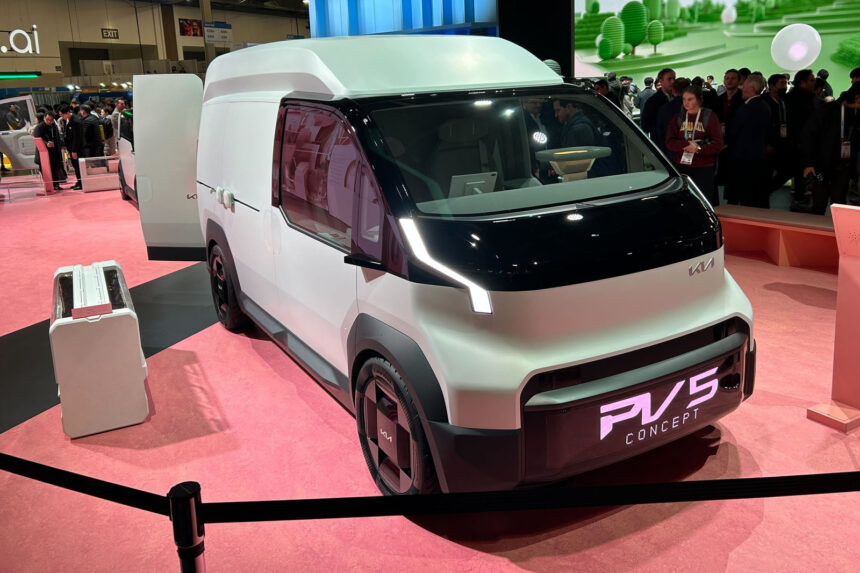Kia is set to make a big splash in the electric van market with the launch of its new PV5 model in the UK. The production version of the PV5 will be unveiled at the Commercial Vehicle Show on 29 April, marking the beginning of Kia’s foray into the commercial vehicle sector.
The PV5 was first showcased as a concept at the CES electronics show in Las Vegas last year, and prototypes have been seen testing in Europe ahead of its official launch. This electric van is just the first in a planned line-up of vans from Kia, with the concept also including smaller PV1 and PV3 models, as well as the larger PV7.
One of the key features of the PV5 is its seven-year, 100,000-mile warranty, offering peace of mind to buyers. Additionally, the van will come equipped with connectivity to the Geotab fleet management platform, allowing for efficient tracking and management of the vehicle.
Paul Philpott, president and CEO of Kia UK, has highlighted the importance of expanding into the commercial vehicle market, noting that there is a significant opportunity for growth in this sector. Deliveries of the PV5 are expected to start in the fourth quarter of the year, between October and December.
The PV5 is just the beginning of Kia’s plans for its electric van business, with a range of models set to follow in the coming years. The PV5 is the first in a series of PBVs (Platform Beyond Vehicle) that Kia is developing, with plans for a variety of sizes and configurations to meet different business needs.
The PV5 is expected to be priced competitively, starting at around €35,000 (£30,600) for an entry-level model. It will be built on a specially adapted version of the E-GMP platform used in other Kia electric vehicles, ensuring high levels of performance and efficiency.
Two versions of the PV5 will be offered at launch – a seven-seat People Mover and a High Roof panel van for cargo transportation. Kia is targeting small and medium businesses with these models initially, with plans to introduce them to the UK market in 2026.
Looking ahead, Kia has ambitious plans for its PBV range, with different models and configurations in the pipeline. The company is also exploring autonomous options, with a Robotaxi version of the PV5 planned for production in 2028.
Overall, the launch of the PV5 marks an exciting new chapter for Kia as it enters the electric van market and expands its presence in the commercial vehicle sector. With a range of models and configurations on the horizon, Kia is poised to make a significant impact in this growing market segment. Kia has introduced a groundbreaking new van, the PV5, which combines tubular steel and engineered polymers to reduce the number of parts needed by 55%, without compromising rigidity. This innovative construction method not only enhances the vehicle’s structural integrity but also contributes to sustainability by using recycled materials in the manufacturing process.
In addition to its advanced materials, the PV5 boasts a range of fleet-management options, including over-the-air software updates, to cater to businesses operating a large number of PBVs. Kia is also developing a PBV Ecosystem that features an integrated rail system on the ceiling, floor, and side of the vehicles, allowing for easy interchangeability of components such as frames, cabinets, and seats between different PBVs.
Looking beyond the vehicles themselves, Kia is working towards integrating robotics and autonomous driving technology into the PBV ecosystem, positioning the PV5 for future smart city environments. This ambitious vision for phase three of the project showcases Kia’s commitment to innovation and sustainability in the commercial vehicle sector.
However, while the PV5 promises to be one of the most advanced vans on the market, questions remain about its market viability. Commercial vehicle buyers prioritize practicality, reliability, and cost-effectiveness over cutting-edge technology and sustainability features. The competitive landscape, dominated by established players like Ford and Volkswagen, presents a challenge for Kia to establish a foothold in the market.
As an International Van of the Year juror, I have my doubts about the PV5’s ability to gain traction in the commercial vehicle industry. While the concept is undoubtedly impressive, Kia will need to not only introduce a new model but also create a market for it in a sector that is traditionally slow to adopt new technologies. The success of the PV5 will hinge on Kia’s ability to convince buyers of the value proposition of its advanced digital features in a market that is still largely analog in its approach to commercial vehicles.







